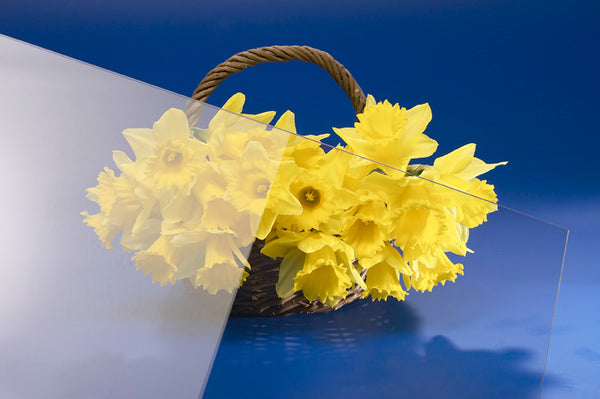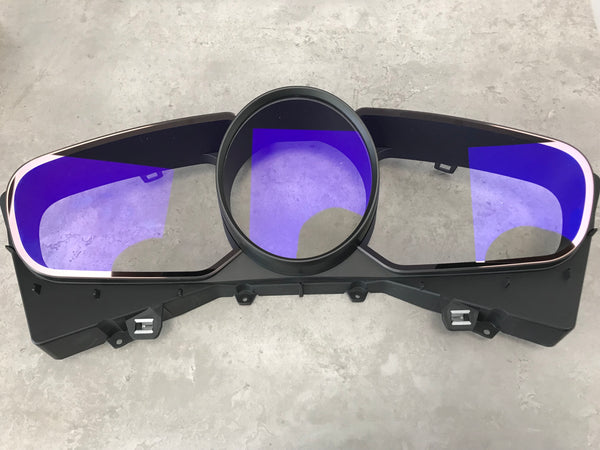Optiguard™ Vacuum AR (Anti-Reflection) Acrylic Sheets
Tax included
100 in stock

Optiguard™ Vacuum AR Acrylic Sheets
Optiguard™ Vacuum AR Coating can offer a solution for a wide variety of applications.

Varying locations and lighting conditions often pose problems with viewing consistency on many types of displays and other surfaces.
- Reduces Specular Reflection where they make viewing difficult.
- Easy-to-clean hydrophobic surface that repels dirt.
- Reduces front surface glare on your hand held device.
- Minimizes Reflections on ATM Screens, Monitors or Instrument panels in automotive application.
Furthermore, Optiguard AR Coatings are specially engineered to reduce reflection and increase transmission.
Vacuum AR Coating Properties
| Properties | Method | Unit | Value |
|---|---|---|---|
| Specific Gravity | ASTM D-792 | 1.19 | |
| Elongation | ASTM D-638 | % | 5 |
| Flexural Rupture Strength | ASTM D-790 | kg/cm2 | 800 |
| Heat Distortion Temperature | ASTM D-648 | °C | 110 |
| Maximum Recommended Continuous Temperature | ASTM D-696 | °C | 80 |
| Coefficient of Thermal Expansion | cm/cm/°C | 7 x 10-5 | |
| Heat Resistance | 80°C x 100hr | No Change | |
| Cold Resistance | -40°C x 100hr | No Change | |
| Humidity Resistance | 40°C x 90% x 100hr | No Change | |
| Thermal Cycle (10 Cycles) | -40°C <=> 80°C | No Change | |
| Sunshine Weather Meter | 100 hr | No Change | |
| Pencil Hardness | 6H ~ 8H | ||
| Shed Water (Touch Angle) | 114° |
The technical data for the product is typical, based on information accumulated during product life, and are not to be used in the generation of purchase specifications, which define property limits rather than typical performance.
How Vacuum AR Coating works

When light reaches an interface between two media it is either transmitted, reflected, or lost to absorption or scattering.
The fraction of light that is reflected (R) is dependent upon the relative refractive indices (n) of the two media, which are related to the velocity of light in each of the two media.
R = [(nair – nacrylic)/(nair + nacrylic)]2
When light traveling in air strikes acrylic, for example, its velocity decreases and a significant amount of light is reflected away from the acrylic surface.
If this acrylic is the front surface of a display then the light available to read the display is reduced and the reflected light diminishes the contrast ratio and the readability of the display image.
This process is repeated at every optically dissimilar interface in the light path, resulting in a cumulative transmission loss that reduces image contrast as seen by the viewer.
Applying a specially designed coating layer to the acrylic surface can reduce the amount of light reflected at an air/acrylic interface.
The amount of reflected light of wavelength is minimized if the coating layer has an optimum refractive index (n) and is coated at an optimum thickness (z).
z = λ/4n
Optiguard AR coatings are specially engineered to reduce reflection and increase transmission of light at air/optical surface interfaces.
This increases contrast ratio in displays and increases transmission through the display window.
In addition to this optical engineering, a final AR layer is added incorporating a low surface energy component, creating an easily cleaned surface known as the AFP (Anti-Finger Print) layer.
Optiguard AR can often be identified by a faint blue/purple colouring of the surface.
This residual or reflex colour can be selected or altered by the number and thickness of layers of metal oxides applied.
Reflectance Spectrum
Optiguard AR coatings can be used in a wide variety of applications where reduction of first surface reflectance is important.

Material Presentation




